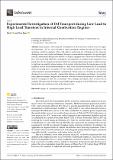Experimental Investigation of Oil Transport during Low Load to High Load Transient in Internal Combustion Engines
Author(s)
Li, Mo; Tian, Tian
Downloadlubricants-11-00076.pdf (9.299Mb)
Publisher with Creative Commons License
Publisher with Creative Commons License
Creative Commons Attribution
Terms of use
Metadata
Show full item recordAbstract
Reducing the Lubricating Oil Consumption (LOC) has been a critical focus for engine manufacturers. LOC not only depends on engine operating condition but also the history of the operating condition variations. This work seeks to understand the oil transport in the ring pack during the low load to high load transient through experimental investigations. An optical engine with 2D Laser Induced Fluorescence (2D-LIF) technique, equipped with a modern low-tension Three-Piece Oil Control Ring (TPOCR), was applied to investigate the oil transport in the ring pack. It was found that, after the engine stayed under the blowby separation line long enough, a sudden increase to high load can result in a huge increase of oil ejection to the liner from the top ring groove in the expansion strokes. The mechanism behind it is that, when the load is increased, the oil accumulated inside the top ring groove during the low load condition is pushed out by the gas flow after the peak cylinder pressure is reached. Different combinations of load, speed, rate of change in load and time duration at low load were tested to examine their influence on this leakage mechanism. An operation with a gradual increase of engine load was found to be able to reduce the amount of oil leaked to the liner by releasing more oil to the second land. These findings can help the effort to reduce the oil emission (OE) generated from Spark Ignited (SI) engines equipped with TPOCR in the real-world transient driving conditions as well as the emission tests.
Date issued
2023-02-11Department
Massachusetts Institute of Technology. Department of Mechanical EngineeringPublisher
Multidisciplinary Digital Publishing Institute
Citation
Lubricants 11 (2): 76 (2023)
Version: Final published version